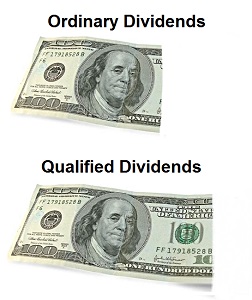 Dividends tend to get lumped as one single form of investment income. But the IRS doesn’t see it that way, dividing the tax on dividends into two types: ordinary and qualified dividends. This is good to know around tax time. But it’s just as important when choosing investments for a taxable account, since taxes are another cost that eat into your returns.
Dividends tend to get lumped as one single form of investment income. But the IRS doesn’t see it that way, dividing the tax on dividends into two types: ordinary and qualified dividends. This is good to know around tax time. But it’s just as important when choosing investments for a taxable account, since taxes are another cost that eat into your returns.
Ordinary Dividends
First, all dividends are considered ordinary dividends. The problem, of course, is how we loosely use the term dividends to describe any type of payout from stocks, mutual funds, savings accounts, or other investments. Sometimes that “dividend” is actually interest income or a capital gains distribution.
To get more specific, ordinary dividends are paid out of earnings and profits. These are taxed at your ordinary income tax rate. This isn’t very efficient as your income climbs into the higher brackets.
The big tax benefit is that some of these ordinary dividends can qualify for a lower tax rate.
Qualified Dividends
Basically, qualified dividends are ordinary dividends that meet specific requirement. If so, the qualified dividends are taxed at the same rate as long-term capital gains. That drops the qualified dividend tax rate down to 20%, 15%, or even 0% depending on your marginal tax rate, which you can find here:
- 0% if you fall into the 10% or 15% bracket
- 15% if you fall into the 25% to 35% bracket
- 20% if you fall into the 39.6% bracket
That can offer big tax savings when planned out correctly. But the dividends must meet the IRS requirements:
- The dividend must be paid by a U.S. corporation or a qualified foreign corporation
- It can’t be a type of non qualified dividend
- It must meet the holding period of more than 60 days during the 121 day period that begins 60 days before the ex-dividend date
Makes sense, right? Let’s break it down further.
U.S. Corporation or Qualified Foreign Corporation
The qualified dividend must be paid by a U.S. corporation that already pays income tax. Or it’s paid by a foreign corporation that benefits from an income tax treaty or trades on a U.S. stock exchange, like ADRs. Most dividend stocks meet this requirement.
Non Qualified Dividends
Non qualified dividends are fairly straight forward but muddy the dividend pool. These are basically distributions that can be confused as dividends:
- Capital gains distribution
- “Dividends” paid on savings deposits that are actually interest (from credit unions, mutual savings banks, or S&L banks)
- Dividends from a tax exempt organization
- Dividends paid on shares held by an ESOP (Employee Stock Ownership Plan)
- Payments in lieu of dividends
Mutual funds are often guilty of this. These funds regularly pay out a capital gains distribution each year. The same goes for funds that pay “dividends” that include interest income from owning taxable bonds.
Fund companies will send you a 1099-DIV that breaks the dividend payment down into each part. Just know that a mutual fund’s dividend can include both ordinary and qualified dividends, along with interest income and capital gains. But you won’t know how it breaks down until you get that 1099 form.
Holding Period
The holding period must be more than 60 days during the 121 day period that begins 60 days before the ex-dividend date. Could this be any more confusing?
I covered the ex-dividend date before, which helps explain this. The ex-dividend date decides which shareholders get paid a dividend. You must own shares on that date to get paid. But, if you buy shares on the ex-dividend date you won’t get the dividend.
Now back to the holding requirement. There’s a 121 day window surrounding the ex-dividend date (60 days before and 60 days after). For the dividend to qualify, you must own the shares for at least 61 days inside that window including the ex-dividend date.
What About Reinvested Dividends?
The same rules apply to reinvested dividends. This includes DRIPs or dividend reinvestment plans. In other words, you get no extra tax benefit for reinvesting dividends. The real benefit comes from the lower transaction costs (typically there’s no transaction cost) and compound returns.
Why The Difference?
It’s the same reason for different capital gains tax rates. It encourages longer term investing. More so, it discourages people from using dividend capture strategies, where you jump in and out of stocks around the ex-dividend dates, just to collect a dividend.
For tax purposes, your fund company or broker should separate ordinary and qualified dividends for you in the 1099-DIV forms. That makes it easier around tax time. But you can take it a step further. By planning ahead, you can make sure most of your ordinary dividends are qualified.
